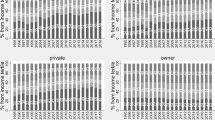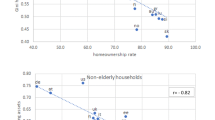Abstract
This paper draws on six waves of Japanese household longitudinal data (Keio Household Panel Survey, KHPS) and estimates a conditional fixed effects logit model to investigate the effects of housing equity constraints and income shocks on own-to-own residential moves in Japan. By looking at contemporaneous extended Loan-to-Value (ELTV) and extended Debt-to-Income (EDTI) ratios under the recourse loan system, we examine whether housing equity constraints and negative income shocks have any impact on own-to-own residential moves. Taking account of the specific nature of the recourse loan system in Japan, we further investigate whether these effects are different between positive and negative equity households. The estimation results show that housing equity constraints and negative income shocks significantly deter own-to-own residential moves for positive equity households.





Similar content being viewed by others
Notes
Long (1991) analyzed residential mobility differences among developed countries. Strassmann (1991) made an international comparison of housing market interventions and mobility. Angel (2000), Table A.25 (p.372) shows annual residential mobility rates as of 1990 among 53 major cities in 53 countries. Harsman and Quigley (1991), Table 1, 2, 3, 4 and Appendix shows annual residential mobility rates among European countries and the U.S.
U.S. data is from the Social Science Data Analysis Network (http://www.censusscope.org/us/s48/chart_migration.html, accessed on November 17, 2009). Canadian data is from Statistics Canada released 2006 census mobility data (http://www12.statcan.gc.ca/census-recensement/2006/dp-pd/index-eng.cfm, accessed on November 17, 2009).
This figure is based on the 2008 Housing and Land Survey of Japan. The annual residential mobility rate was 8.1% between 1968 and 1973, 7.5% between 1973 and 1978, 6.8% between 1978 and 1982, 6.2% between 1982 and 1988, 6.1% between 1988 and 1993, 5.8% between 1993 and 1998, 5.1% between 1998 and 2003, and 4.4% between 2003 and 2008.
Seko and Sumita (forthcoming) surveyed trends and prospects in Japan’s Mortgage Market.
Leung (2004) surveyed research focusing on the relationship between housing price cyclicality, volatility and the structure of the residential lending market.
An empirical counterpart of this variable is discussed in further detail in Section 6.2.
It should be noted that, compared with our model based on the recourse loan system, non-recourse loan contracts can yield somewhat different results. Under the non-recourse contract, the down payment constraint for a defaulting household would be γPH ≤ W instead of Eq. (2). Because non-housing asset W can be positive even for negative equity households, under the non-recourse loan contract they can rationally default and move to a new house (with a certain cost for defaulting).
Our ELTV is similar to Chan’s (2001, p.578) extended LTV. However, our ELTV is devised explicitly taking into consideration the characteristics of the recourse loan system. Moreover, Chan did not conduct empirical analysis using the extended LTV. We have also devised another variant of LTV, i.e. adding saving and securities into the denominator (Seko et al. 2009). Both variants of LTV exhibit qualitatively similar results.
For those households that did not provide the self-reported value, we impute (using hedonic regression) the missing self-reported value. In doing so, we first estimate the hedonic regression with fixed effects by using the existing (non-missing) self-reported value and housing attributes information available from the questionnaire. The estimation result is reported in Appendix. Using the regression result, we then compute the truncated predictor to impute the missing house value. This is the predictor that uses the coefficient estimates of the hedonic model without the fixed effects in order to make up for the missing observations (Baillie and Baltagi 1999). For households that provided the self-reported house value data, we compute the fixed effects predictor.
Equal monthly payments including interest are the most widespread repayment method in Japan.
For the mortgage interest rate, we use the base interest rate (kijun kinri) of the Japan Housing Finance Agency. (http://www.jhf.go.jp/customer/yushi/kinri/suji_kikouyushi.html, accessed on November 9, 2009)
Since the standard error of the difference is 1.4123 and z statistic that follows standard normal distribution under the null hypothesis of no difference is 0.49 and the P-value is 0.622, the null hypothesis cannot be rejected.
There is no standard rule, but in Japan down payments range from 10% to 20% of the purchase price.
Note that, at the same time, a greater burden of repayment gives an incentive to move to a smaller home. Therefore EDTI may have a positive effect on residential mobility. Our estimate here is net of these two effects.
See Cameron and Trivedi (2005, p.273) for detail.
Observations with regional LTV = 0 or LTV >2 are excluded from Figure 5. Households with zero regional LTV ranges from 26.3% to 29.4% during our sample period.
References
Andrew, M. (2004). A permanent change in the route to owner occupation? Scottish Journal of Political Economy, 51(1), 24–48.
Angel, S. (2000). Housing policy matters: A global analysis. Oxford: Oxford University Press.
Baillie, R. T., & Baltagi, B. H. (1999). Prediction from the regression model with one-way error components. In C. Hsiao, K. Lahiri, L.-F. Lee, & M. H. Pesaran (Eds.), Analysis of panels and limited dependent variable models. Cahpter 10 (pp. 255–267). Cambridge: Cambridge University Press.
Börsch-Supan, A. (1987). Econometric analysis of discrete choice, with applications on the demand for housing in the United States and West Germany, lecture notes in economics and mathematical systems, 296. Berlin: Springer Verlag.
Börsch-Supan, A. (1990). Panel data analysis of housing choices. Regional Science and Urban Economics, 20, 65–82.
Cameron, A. C., & Trivedi, P. K. (2005). Microeconometrics: Methods and applications. Cambridge: Cambridge University Press.
Chamberlain, G. (1980). Analysis of covariance with qualitative data. The Review of Economic Studies, 47, 225–238.
Chan, S. (1996). Residential mobility and mortgages. Regional Science and Urban Economics, 26, 287–311.
Chan, S. (2001). Spatial lock-in: Do falling house prices constrain residential mobility? Journal of Urban Economics, 49, 567–586.
Deng, Y., Quigley, J. M., & Van Order, R. (2000). Mortgage terminations, heterogeneity and the exercise of mortgage options. Econometrica, 68(2), 275–307.
Engelhardt, G. V. (2003). Nominal loss aversion, housing equity constraints, and the household mobility: Evidence from the United States. Journal of Urban Economics, 53(1), 171–195.
Englund, P., & Ioannides, Y. M. (1993). The dynamics of housing prices: An international perspective. In D. Bos (Ed.), Economics in a changing world (pp. 175–197). NY: Macmillan.
Ferreira, F., Gyourko, J., & Tracy, J. (2010). Housing busts and household mobility. Journal of Urban Economics, 68(1), 34–45.
Genesove, D., & Mayer, C. J. (1997). Equity and time to sale in the real estate market. The American Economic Review, 87(3), 255–269.
Genesove, D., & Mayer, C. J. (2001). Loss aversion and seller behavior: Evidence from the housing market. Quarterly Journal of Economics, 116(4), 1233–1260.
Green, R., Sanders, A. B., & Wachter, S. (2008). Special issue on Sub-prime mortgage lending. Journal of Housing Economics, 17, 4.
Hardman, A. M., & Ioannides, Y. M. (1999). Residential mobility and the housing market in a two-sector neoclassical growth model. Scandinavian Journal of Economics, 101, 315–335.
Harsman, B. and Quigley, J. M., (1991). Housing markets and housing institutions: An international comparison. Kluwer Academic Publishers.
Henley, A. (1998). Residential mobility, housing equity and the labour market. The Economic Journal, 108, 414–427.
Lee, N. J., & Ong, S. E. (2005). Upward mobility, house price volatility, and housing equity. Journal of Housing Economics, 14, 127–146.
Leece, D., (2004). Economics of the Mortgage Market, Blackwell Publishing.
Leung, C. (2004). Macroeconomics and housing: A review of the literature. Journal of Housing Economics, 13, 249–267.
Long, L. (1991). Residential mobility differences among developed countries. International Regional Science Review, 14, 133–147.
Ortalo-Magne, F., & Rady, S. (2006). Housing market dynamics: On the contribution of income shocks and credit constraints. The Review of Economic Studies, 73, 459–485.
Rosenthal, S. S., & Strange, W. C. (2008). Mortgages and the housing crash: A symposium. Journal of Urban Economics, 64, 2.
Seko, M., & Sumita, K. (2007). Effects of government policies on residential mobility in Japan: Income tax deduction system and the rental act. Journal of Housing Economics, 16(2), 167–188.
Seko, M. and Sumita, K., (forthcoming). Trends and prospects in Japan’s mortgage market. In: International encyclopedia of housing and home, Elsevier Limited.
Seko, M., Sumita, K. and Naoi, M., (2009). Residential mobility decision in Japan: Identifying the effects of housing equity constraints and income shocks under the recourse loan system, Keio economic society Discussion Paper Series, No. 09–3.
Seslen, T.N., (2003). Housing price dynamics and household mobility decisions. MIT Ph.D. Thesis.
Stein, C. J. (1995). Prices and trading volume in the housing market: A model with down-payment effects. Quarterly Journal of Economics, 110(2), 379–406.
Strassmann, W. P. (1991). Housing market interventions and mobility: An international comparison. Urban Studies, 28, 759–771.
Author information
Authors and Affiliations
Corresponding author
Additional information
An earlier version of this paper (Seko, Sumita, and Naoi, 2009) was presented at the Asian Real Estate Society-American Real Estate and Urban Economics Association Joint International Conference, the University of California, Los Angeles, July 11–14, 2009, and received the Best Paper Award (the Maury Seldin Advanced Studies Institute Award). It was also presented at the Asia Pacific Real Estate Research Symposium at the University of Southern California, July 10–11, 2009 and at the 2009 Fall Annual Meeting of the Japan Economic Association at Senshu University, October 10–11, 2009. We are grateful for Danny Ben-Shahar, Peng Liu, Seow Eng Ong, Gary Painter, Chihiro Shimizu, Fukuju Yamazaki, participants of the conferences and two anonymous referees for their helpful comments.
Appendix
Appendix
Rights and permissions
About this article
Cite this article
Seko, M., Sumita, K. & Naoi, M. Residential Mobility Decisions in Japan: Effects of Housing Equity Constraints and Income Shocks under the Recourse Loan System. J Real Estate Finan Econ 45, 63–87 (2012). https://doi.org/10.1007/s11146-011-9322-3
Published:
Issue Date:
DOI: https://doi.org/10.1007/s11146-011-9322-3
Keywords
- Residential mobility
- Housing equity constraint
- Conditional fixed effects logit model
- Loan-to-value ratio
- Debt-to-income ratio
- Negative equity
- Japan
- Recourse loan




